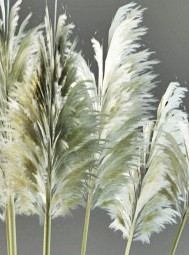 Many grasses dry well and can be used in winter arrangements. The materials are inexpensive, the process is simple, and the rewards are outstanding. For very little time and money you can produce a beautiful collection of dried grasses that can be used with each other or with fresh or dried flowers, cones, and pods. Arrangements can be large or small, last a week or months, your choice. But plan ahead because for best results you must collect your grasses when they are ready.
Many grasses dry well and can be used in winter arrangements. The materials are inexpensive, the process is simple, and the rewards are outstanding. For very little time and money you can produce a beautiful collection of dried grasses that can be used with each other or with fresh or dried flowers, cones, and pods. Arrangements can be large or small, last a week or months, your choice. But plan ahead because for best results you must collect your grasses when they are ready.
Supplies:
-
Wire coat hangers or laundry line, hung in cool, dark, dry place
Paper covered twists
Sharp scissors
Grasses
Directions
-
1. Gather grasses on a dry sunny afternoon after morning moisture has evaporated and before evening moisture begins to collect.
2. Choose stems with flowers that are not completely open (they will continue to open for a day or two after being cut)
3. Cut stems as long a possible with sharp scissors (you can always cut them shorter when you go to use them).
4. Remove the leaves
5. Gather the grasses in small bunches, secure with paper covered twists, and hang from coat hangers or laundry line in a cool, dark, dry place, separating the bunches so the air can freely flow around them . The coolness slows the evaporation of moisture from the plant so shrinkage is reduced; the darkness retards fading, and the dryness and spacing prevents mold and mildew formation.
6. Check the bunches evey few days and re-tie bundles that have become loose. The bunches should be ready in two to four weeks.
7. Spray very delicate seeds heads lightly with hair spray to prevent them from shattering.
Suggestions
-
1. Some grasses like Miscanthus, pampus grass, and cattails (Typa spp) have tough stems and can be dried by standing up in tall containers placed in cool, dark, dry, airy places.
2. Some grasses, like Miscanthus have leaves that can be dried and used as filler in arrangements. The leaves of lemongrass (Cymbogon citrates), sweet vernal grass (Anthoxanthum odoratum), and khus-khus (Vetiveria zizanioides) are fragrant.
3. Grass that dry especially well include: big quaking grass (Brizia maxima), Miscanthus, northern sea oats (Chasmanthium latifolium), switch-grass (Panicum spp), pampus grass (Cortaderia selloana), tufted hair grass (Deschampsia spp.), and hare’s tail (Lagurus ovata).
